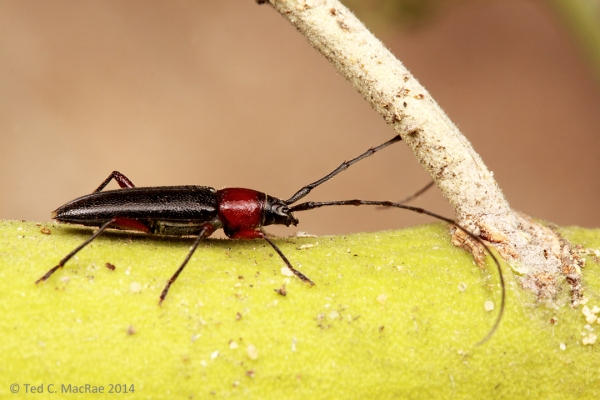Summertime is go time for most entomologists, especially those who conduct field work both as a profession and as a hobby. Far flung field sites and the need to travel between them eats up most of each week, while on weekends clipboard and spreadsheets are exchanged for beating sheet and hatchet before traveling to other sites with the promise of some cool species of beetles. Even the most peripatetic entomologist, however, needs a break, and in late July I packed up my swim trunks, rounded up the girls, and headed off for a week of rest and relaxation on the beaches of Cabo San Lucas, Mexico.
Of course, you’re not a real entomologist if you don’t sneak off once or twice for a peak at the local flora and fauna with a vial that just happens to be in your pocket. Despite the rampant development in the area, reasonably extensive parcels of the original San Lucan xeric scrub habitat are accessible to those willing to hike a few miles up the beach. This unique, dry shrubland occurs only at the southern tip of the peninsula, extending from the coast up to about 250 meters in elevation. About ten percent of San Lucan scrub biota is endemic as a result of separation from more northern parts of the peninsula until the Miocene (23–5 mya). Xeric scrub is normally dry, brown, and dusty, but rains prior to my visit had created a verdant landscape with (relatively) lush foliage and an abundance of flowers. Insects were strangely scarce, however, save for a nice diversity of heavily sculptured darkling beetles (family Tenebrionidae), which I encountered along 2-tracks running through the habitat, and a few wood-boring beetles that were found on recently wind-thrown branches of palo verde (Cercidium floridum).

Chrysobothris octocola on Cercidium floridum ssp. peninsulare | Cabo San Lucas, Baja California Sur, Mexico

Adults ran rapidly on the fresh wind-thrown branches
Given the level of endemism in the area, I was hoping the beetles would prove to be examples of such, or at least species restricted to Baja California that I had not encountered before. Alas, both proved to be not only more widespread in Mexico but species occurring commonly in the southwestern U.S. as well. I suppose finding endemic species right off the bat after a quick jaunt up the beach while on a family vacation is a bit much to expect, although I suspect the palo verde trees on which I found the beetles represents the endemic subspecies Cercidium floridum ssp. peninsulare. And I got some nice photos.

Stenosphenus sobrius on Cercidium floridum ssp. peninsulare | Cabo San Lucas, Baja California Sur, Mexico

Adults were found resting on the undersides of fresh wind-thrown branches
© Ted C. MacRae 2015
I’ve missed reading your posts! Had a bit of a break from the blogging world. Really liked this post. You are a great writer!
Thank you, Lisa. I always appreciate your nice comments.
I had a strange Lep encounter in Cabo about 20 years ago. I took a moment off from offshore fishing to examine a sphinx moth near a light by my room. When I touched it to make it show its hindwing color, the moth flew in my face, hitting my cap just above the bill. I removed the cap from my head only to discover a large blood-red stain on the crown. I have to assume this came from the moth, as some sort of defensive mechanism. Have you ever heard of this sort of behavior in sphinx moths? I haven’t.
Can’t say that I’ve ever heard of that. I know many adult moths can eject a brown liquid if they are disturbed shortly after emergence, but the blood-red part of it seems odd since insect body fluids lack hemoglobin and instead contain plant-based pigments. Are you sure the stain came from the moth? No chance of another source?
No chance of another source; it was still wet when I examined it. it may have been more brownish than bright red, though. I didn’t photograph it and am relying on my memory. Thanks for responding.
Yep, that’s how I behave on family vacations, too. Nice pictures, even if not those San Lucan endemics you hoped for.